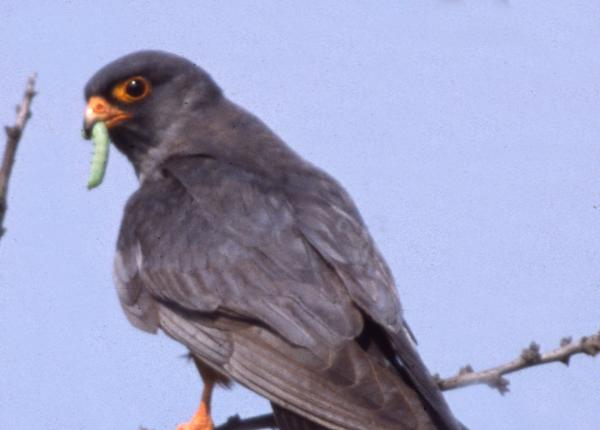Did You Know?
- The first breeding record for this species in Italy was in 1995. Today, there is a small breeding population with an estimated 60 pairs.
- This species tends to be most active - hunting and flying - at dawn and dusk
- To date, the oldest known Red-footed Falcon is 12 years old
How The Peregrine Fund is Helping
Though The Peregrine Fund doesn't work directly with Red-footed Falcons, our efforts in scientific research, habitat conservation, education, and community development help conserve raptors on a global scale. We also supply literature to researchers from our avian research library, which helps scientists around the world gather and share important information on raptor conservation.
Where They Live
The Red-footed Falcon is found in parts of Europe and Asia, and it overwinters in Africa. It prefers more open habitats that do provide some tree cover.It can be found in steppe, grasslands, savannas, riparian woodlands, and cultivated fields and orchards.
What They Do
True to its name, the Red-footed Falcon has red feet! The males and females differ in color. The males are an overall grayish color, while the females are a light brown color and grayish wings. The Red-footed Falcon is migratory.
Why They Need Our Help
This falcon is categorized as Vulnerable, and its populations appear to be in decline. Loss of habitat is one threat to this lovely falcon.
What They Eat
The Red-footed Falcon, like many falcons, eats a wide variety of prey. Insects, such as crickets and grasshoppers, beetles, moths, and dragonflies, make up a large part of its diet. It will also consume small birds, rodents, amphibians, and reptiles.
Nests, Eggs and Young
Like other falcons, the Red-footed Falcon doesn't build its own nest. Instead, it uses old nests of other birds, including other raptors. They might also nest inside cliffs or in holes in trees, or even on the ground. This species is a colony nester, meaning hundreds of pairs of falcons nest in close proximity to each other.The female will lay between 3-4 eggs, which are are a reddish-brownish color. Both the male and female will take on incubation duties to make sure their offspring develop into healthy nestlings. After the nestlings hatch, they will grow quickly and will be ready to fly from the nest for the first time when they are around one month old.
Red-footed Falcon and World Center for Birds of Prey
Though we don't house any Red-footed Falcons at the World Center for Birds of Prey, we have a number of interesting falcon species that serve as avian ambassadors during presentations and flight shows. American Kestrels, Peregrine and Aplomado Falcons, among others, can be seen at our center. We also offer many other fun ways to learn about birds of prey. The visitor center has interactive displays, tours, interesting videos and a children's room with activities from coloring sheets to quizzes to costumes and a touch table for the curious mind. Knowledgeable staff and volunteers are on hand to answer any questions you may have about Red-footed Falcons or any other bird of prey.
References:
BirdLife International. 2021. Falco vespertinus. The IUCN Red List of Threatened Species 2021: e.T22696432A200136196. https://dx.doi.org/10.2305/IUCN.UK.2021-3.RLTS.T22696432A200136196.en. Accessed on 28 November 2022.
Global Raptor Information Network. 2022. Species account: Red-footed Falcon Falco vespertinus. Downloaded from http://www.globalraptors.org on 26 Nov. 2022
Orta, J., G. M. Kirwan, and C. Hansasuta (2022). Red-footed Falcon (Falco vespertinus), version 1.1. In Birds of the World (B. K. Keeney, Editor). Cornell Lab of Ornithology, Ithaca, NY, USA. https://doi.org/10.2173/bow.reffal1.01.1









